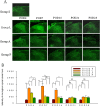Pretreatment with intrathecal amitriptyline potentiates anti-hyperalgesic effects of post-injury intra-peritoneal amitriptyline following spinal nerve ligation
- PMID: 22720761
- PMCID: PMC3519508
- DOI: 10.1186/1471-2377-12-44
Pretreatment with intrathecal amitriptyline potentiates anti-hyperalgesic effects of post-injury intra-peritoneal amitriptyline following spinal nerve ligation
Abstract
Background: Amitriptyline, a tricyclic antidepressant and potent use-dependent blocker of sodium channels, has been shown to attenuate acute and chronic pain in several preclinical modes. The purpose of this study was to investigate whether intrathecal pretreatment with amitriptyline combined with post-injury intra-peritoneal amitriptyline is more effective than post-injury treatment alone on L5 spinal nerve ligation (SNL)-induced neuropathic pain.
Methods: 96 adult male Sprague-Dawley rats were allocated into 4 groups: group S, Sham; group L, L5 spinal nerve Ligation with vehicle treatment; group A, SNL and post-injury intra-peritoneal (Abdominal) amitriptyline twice daily × 3 days; group P, intrathecal Pretreatment with amitriptyline, SNL and intra-peritoneal amitriptyline twice daily × 3 days. Responses to thermal and mechanical stimuli, as well as sodium channel expression in injured dorsal root ganglion (DRG) and activated glial cells in spinal dorsal horn (SDH) were measured pre-operatively and on post-operative day (POD) 4, 7, 14, 21 and 28.
Results: SNL-evoked hyper-sensitivity responses to thermal and mechanical stimuli, up-regulated Nav1.3 and down-regulated Nav1.8 expression in DRG, and activated microglia and astrocytes in SDH. In group A, intra-peritoneal amitriptyline alone alleviated thermal hypersensitivity on POD7, reversed Nav1.8 and reduced activated microglia on POD14. In group P, intrathecal pretreatment with amitriptyline not only potentiated the effect of intra-peritoneal amitriptyline on thermal hypersensitivity and Nav1.8, but attenuated mechanical hypersensitivity on POD7 and reduced up-regulated Nav1.3 on POD14. Furthermore, this treatment regimen reduced astrocyte activation on POD14.
Conclusions: Concomitant intrathecal pretreatment and post-injury intra-peritoneal amitriptyline was more effective than post-injury treatment alone on attenuation of behavioral hypersensitivity, decrease of activated microglia and astrocytes and dysregulated Nav1.3 and 1.8.
Figures





Similar articles
-
Pre-emptive intrathecal quinidine alleviates spinal nerve ligation-induced peripheral neuropathic pain.J Pharm Pharmacol. 2011 Aug;63(8):1063-9. doi: 10.1111/j.2042-7158.2011.01318.x. Epub 2011 Jun 11. J Pharm Pharmacol. 2011. PMID: 21718290
-
Intrathecal lidocaine pretreatment attenuates immediate neuropathic pain by modulating Nav1.3 expression and decreasing spinal microglial activation.BMC Neurol. 2011 Jun 16;11:71. doi: 10.1186/1471-2377-11-71. BMC Neurol. 2011. PMID: 21676267 Free PMC article.
-
Intrathecal CGS-26303 Pretreatment Attenuates Spinal Nerve Ligation-Induced Neuropathic Pain in the Spinal Cord.World Neurosurg. 2016 Jul;91:532-541.e1. doi: 10.1016/j.wneu.2016.02.093. Epub 2016 Mar 4. World Neurosurg. 2016. PMID: 26947729
-
Analgesic properties of loperamide differ following systemic and local administration to rats after spinal nerve injury.Eur J Pain. 2012 Aug;16(7):1021-32. doi: 10.1002/j.1532-2149.2012.00148.x. Epub 2012 Apr 16. Eur J Pain. 2012. PMID: 22508374 Free PMC article.
-
Chronic administration of amitriptyline differentially alters neuropathic pain-related behaviour in the presence and absence of a depressive-like phenotype.Behav Brain Res. 2015 Feb 1;278:193-201. doi: 10.1016/j.bbr.2014.09.044. Epub 2014 Oct 6. Behav Brain Res. 2015. PMID: 25300472
Cited by
-
Blockade of Nav1.8 currents in nociceptive trigeminal neurons contributes to anti-trigeminovascular nociceptive effect of amitriptyline.Neuromolecular Med. 2014 Jun;16(2):308-21. doi: 10.1007/s12017-013-8282-6. Epub 2013 Nov 30. Neuromolecular Med. 2014. PMID: 24292897
-
Full-length membrane-bound tumor necrosis factor-α acts through tumor necrosis factor receptor 2 to modify phenotype of sensory neurons.Pain. 2013 Sep;154(9):1778-1782. doi: 10.1016/j.pain.2013.05.038. Epub 2013 May 24. Pain. 2013. PMID: 23711481 Free PMC article.
-
Ambroxol for the treatment of fibromyalgia: science or fiction?J Pain Res. 2017 Aug 16;10:1905-1929. doi: 10.2147/JPR.S139223. eCollection 2017. J Pain Res. 2017. PMID: 28860846 Free PMC article.
-
Palmitoylethanolamide reduces pain-related behaviors and restores glutamatergic synapses homeostasis in the medial prefrontal cortex of neuropathic mice.Mol Brain. 2015 Aug 12;8:47. doi: 10.1186/s13041-015-0139-5. Mol Brain. 2015. PMID: 26260027 Free PMC article.
-
Repurposing psychiatric medicines to target activated microglia in anxious mild cognitive impairment and early Parkinson's disease.Am J Neurodegener Dis. 2016 Mar 1;5(1):29-51. eCollection 2016. Am J Neurodegener Dis. 2016. PMID: 27073741 Free PMC article. Review.
References
-
- Benedetti F, Vighetti S, Amanzio M, Casadio C, Oliaro A, Bergamasco B, Maggi G. Dose–response relationship of opioids in nociceptive and neuropathic postoperative pain. Pain. 1998;74(2–3):205–211. - PubMed
Publication types
MeSH terms
Substances
LinkOut - more resources
Full Text Sources
Medical
Miscellaneous

